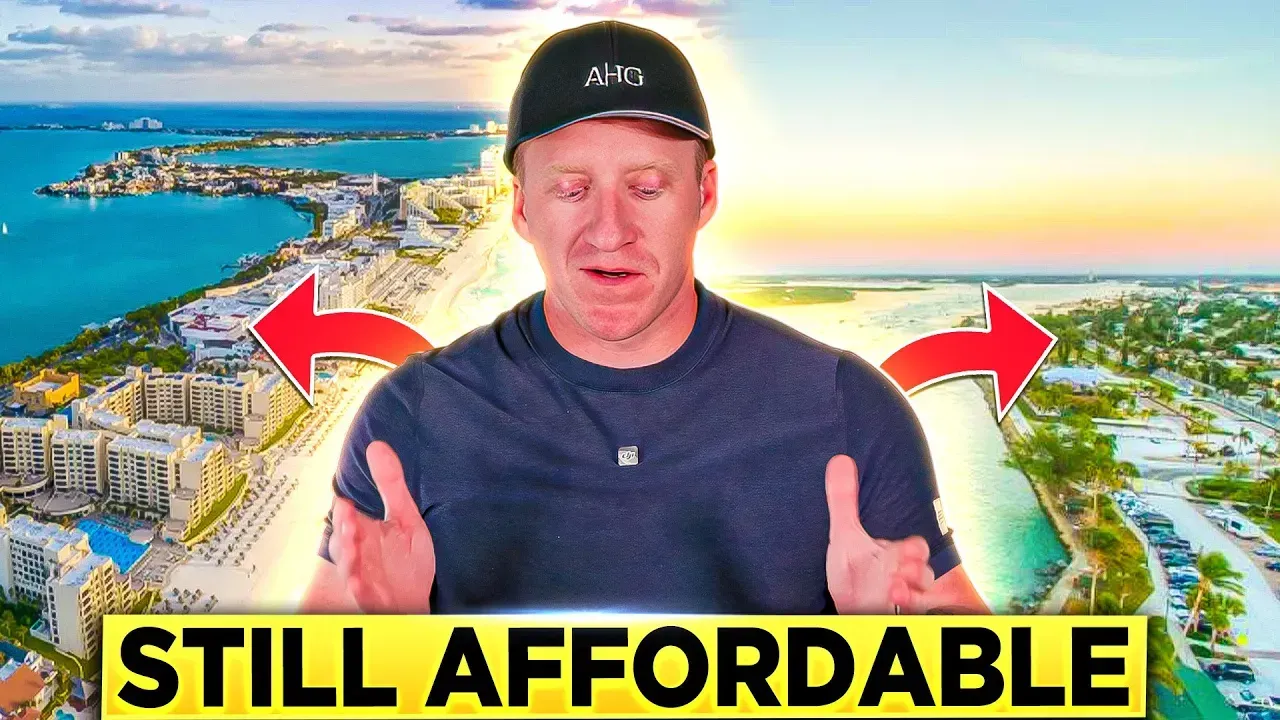We Have More BUYERS Than SELLERS (💥boom or bust😰)???
The real estate market has undergone some dramatic shifts over the past few years. Record low mortgage rates and a surge of buyers fueled an intensely competitive seller’s market, especially in popular migration destinations like Florida.
In this evolving situation, buyers may feel discouraged. But opportunistic purchasers can still find ways to locate properties and negotiate favorable deals. By understanding the underlying trends, you can make informed decisions about timing and strategy. This guide examines the current forces shaping real estate and how savvy buyers can respond.
This article was derived from my full-length YouTube video. You can view it at the bottom of the page.
Part 1: Buyer Confidence & Interest Rates
After two years of frenzied competition and escalating home prices, many buyers grew fatigued. At the same time, rising mortgage rates eroded affordability. This combination made purchasers increasingly hesitant, slowing the blistering pace of sales.
In particular, many buyers delayed decisions while hoping rates might drop or more inventory might hit the market. However, as 2024 gets underway, a consensus is emerging that neither scenario is likely. Rates may inch downward slightly but extreme lows are probably gone. And new listings are not increasing nearly enough to meet demand.
As a result, patient buyers now have a clearer picture of the conditions they face. With less uncertainty about interest rates and inventory, more purchasers have the confidence to move forward. They recognize today’s environment "is what it is” and are ready to transact in that context. This renewed willingness to buy supports a still competitive sales climate as migration trends sustain underlying hunger for homes.
Part 1: Net Migration Patterns
Over the past several years, many regions like SW Florida saw an enormous influx of new residents. In some cases, arrivals that might have occurred over 5-10 years were condensed into a short period as factors like remote work accelerated planned moves. This rapidly escalating net migration significantly outpaced new housing construction, squeezing inventory.
These migration trends show little sign of slowing in 2024+. Workers that relocated and adopted permanent remote or hybrid arrangements have put down roots. Meanwhile, the Sunbelt regions drawing retirees and second home buyers continue gaining popularity. Since housing supply is not expanding at the same velocity, shortages persist.
Adding more pressure, existing residents in the most impacted cities are now departing for smaller towns seeking refuge. This secondary wave of intra-state relocations means even metro areas once considered undiscovered are grappling with dwindling inventory. With move-in demand outweighing move-out supply across several southern state markets, sellers retain leverage for the foreseeable future.
Part 1: Seller Reluctance
Another factor sustaining the supply shortage is sellers’ hesitance to list existing properties. Investors and homeowners who purchased several years ago or even amidst 2020’s pandemic price drops have substantial equity. However, these embedded owners are reluctant to sell in the same heated market where finding their next home would prove extremely difficult.
This “locked-in” phenomenon limits the number of new resale listings hitting the MLS. Sellers with considerable untapped equity do not want to relinquish their current property without assurance they can achieve a successful purchase afterwards. Since bidding wars and bloated prices make trading up prohibitive, these owners stay put.
Some may opt to tap their equity via cash-out refinances or lines of credit. But most embedded owners remain in a holding pattern, unwilling to make a move that could force them into interim rentals or temporary lodging. By removing these potential sellers from inventory, this lock-in effect allows buyer demand to continue eclipsing availability.
Part 1: Local Economic Factors
Of course, not all real estate markets follow the same trajectory. While the overall environment favors sellers, local and hyperlocal conditions can shift the balance. Key factors like major corporate relocations or infrastructure investments that expand job markets without concurrently increasing housing stock are particularly impactful.
When an area adds thousands of new positions without a proportional expansion of residential units, housing crises emerge. Employees relocating into undersupplied neighborhoods squeeze rents and for-sale listings higher through sheer competition. Regions witnessing large job additions without corresponding housing creation substantiate durable seller leverage for years into absorption phases.
On the micro level, local developments alter commuting patterns and desirability as well. Apartment projects, mixed-use buildings, or transit improvements make specific neighborhoods more attractive by easing access or enriching amenities. As these sub-areas see demand spikes amid stagnant supply, pricing climbs correspondingly. Savvy buyers investigate emerging hotspots early before the masses catch on.
Part 2: New Home Construction
Given resale inventory constraints, homebuilders represent the best prospects for alleviating purchase difficulties. New construction can bring inventory online faster than existing owners listing properties. And builders aim for volume sales within planned communities unlike individual sellers seeking to maximize profits on a one-off basis.
Major national builders like Lennar, DR Horton, etc., have huge projects across regions like Florida constantly delivering new homes. Since these firms focus on speed, affordability, and scattered site selection, they actively balance cost efficiencies with location desirability. Developments range from entry level condos to luxury golf villas but concentrate on the mid-market.
For buyers, builder inventory offers potential advantages whether purchasing directly or making offers on quick resales. Construction companies have more flexibility on contract terms because they are not attached to a specific property emotionally or financially. Negotiating with these vendors reduces uncertainties about appraisal gaps, inspection issues, and closing contingencies.
Additionally, builders now recognize interest rates are unlikely to hit all-time lows again. So they increasingly incentivize early buyer commitments via temporary buydowns priced into their projects. Where once a purchaser might wait and hope for lower financing costs, now acting decisively nets the best terms. Hence for both availability and incentives, newly built homes warrant priority attention from buyers expecting to compromise amid shortages.
Part 2: The “Ripple” Forecast
Not every buyer can afford or wishes to live inside the trendiest core neighborhoods drawing peak demand. However, watching the diffusion of popularity to adjoining areas allows smart purchasers to position themselves strategically. The process resembles the epicenter of a quake releasing widening ripples outward.
Initially, urgency focuses on a singular locale whether that represents downtown or the coastline or both. But as prices and competition exclude more buyers, attention shifts to adjacent neighborhoods that offer proximity without the premier pedigree. This phenomenon recursively repeats as each successive area appreciates over time, forcing the quest outward.
Perceptive purchasers try detecting the next ripple early based on insight into expansion limitations and natural geography. Examining where future development is possible clarifies which zones are likely to experience demand flows rather than dead ends. Analyzing road networks, commercial permits, school capacity, and buildable acreage illuminates areas of interest before the masses catch on.
Essentially, observing the market’s evolution guides buyers pursuing maximum future resale value without overpaying upfront. The process encourages probing beyond surface level “comps” using perspective on community intricacies. Applying this technique helps buyers capitalize on inevitabilities around demand rippling through metro sectors as availability declines.
Part 2: Logistics & Flexibility Negotiation Tactics
Finally, buyers should remember seller power does not automatically nullify their leverage completely. Creative negotiating around terms rather than just price can produce mutually beneficial outcomes. Especially for builders or affluent sellers, flexibility around closing, possession, assumption, and interim rental provisions may override moderate pricing gaps.
Option agreements make contingent offers safer for buyers while still appealing to sellers weighing uncertainty. When winning means outbidding competitors, customizable agreements become decisive. Terms allowing sellers months of post-close occupancy or multi-year vesting periods can sway decisions where appraisal and inspection demands might disqualify conventional bids.
Additionally, transferring properties via assumable mortgages circumvents financing contingencies. When interest rates were dropping, assumptions did little for buyers. But now that rates are stalled, keeping long-term low fixed rates boosts feasibility. Even modest concessions like covering closing costs may attract sellers more than inflated offers without custom provisions.
In transactions where wealthier individual and institutional sellers dominate, the numbers matter less than the mechanics to the owners. Bridging logistical gaps makes odds of acceptance higher than formulaic escalating bids. Where residential markets get overheated, adapting to off-market possibilities and unorthodox terms allows buyers to still pinpoint value.
----
Navigating real estate markets today requires proactive perspective and willingness to pivot as conditions constantly evolve. While the overall landscape unequivocally favors sellers, opportunities do exist for buyers who selectively survey, strategize, and customize approaches. Tracking macro migration patterns, monitoring micro trends, and targeting non-mainstream inventory sources allows buyers to mitigate obstacles.
No universal blueprint guarantees home purchasing success amid inventory shortages and climbing rates. However following the guidelines around builder incentives, ripple trajectories, and flexible offers improves the possibilities. The key for buyers involves acknowledging the current climate while pursuing prospects suited to individual positioning. With realistic expectations, proactive planning, and creative solutions, buyers can still achieve homeownership even in stringent seller markets.
Categories
Free Relocation Guides
The YouTube Channel
Watch The Latest With Adam Hancock
Each week I'll give my view on everything from the best neighborhoods around Southwest Florida and new construction communities.

One of the most unique things about our brokerage is how we view the real estate experience!
When you work with The Sunshine State Co team you get Adam, the broker, & your own dedicated agent. This formula provides clients with a full-time market researcher (aka - the best info possible), read more...
LIke Free stuff?
Florida guides, tools & more!
The absolute SMARTEST way to relocate and/or invest in the entire state of Florida. We create an abundance of original, value-based and economics-first resources to equip our clients for the real estate market ahead. Smarter buyers are more savvy buyers!

Sunshine State Company
Ready to take the next step?
Let's schedule a meting! During this initial consultation, we'll learn more about your situation and what you're seeking in a home. We'll provide advice and address any concerns you may have, in order to determine the best approach to achieving your goals. By the end of our conversation, we'll have a solid plan of action and next steps for moving forward.










